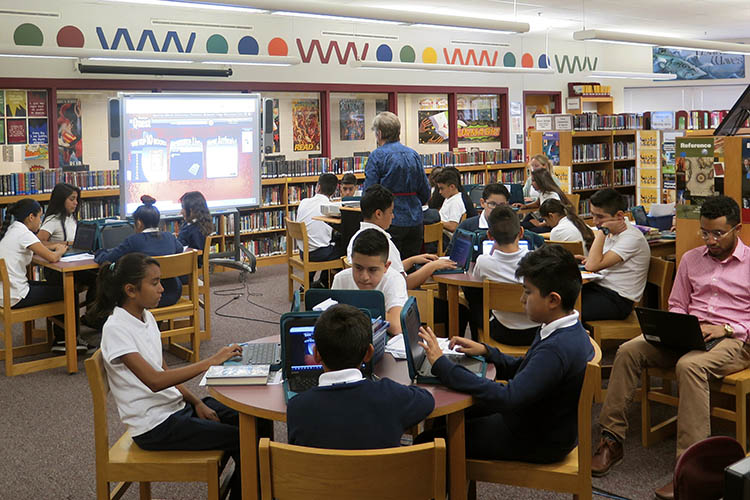School segregation worsens for Latino children compared with a generation ago

This story was originally published by the American Educational Research Association.
Latino children are likely to enter elementary schools this year with fewer white peers than a generation ago, judging by data reported in a new study published today in Educational Researcher, a peer-reviewed journal of the American Educational Research Association.
However, as racial segregation has intensified, low-income students of all racial groups are likely to learn beside more middle-class pupils than before.
In 1998, on average, the nation’s Latino children attended elementary schools in which nearly 40 percent of their schoolmates were white. By 2010, that percentage fell to just 30 percent nationwide, according to the study by researchers from the University of California, Berkeley; the University of Maryland; and the University of California, Irvine. Overall, Latino children today make up more than one quarter of the 35.5 million students attending elementary schools.
Yet the researchers also found that low-income children, regardless of their race or ethnicity, increasingly attend schools with middle-class peers, a development that benefits black and Asian-heritage students as well as Latinos.
“Set amidst high levels of racial segregation, the widening economic integration of students offers an unexpected surprise,” said study coauthor Bruce Fuller, a sociologist at the University of California, Berkeley.

The scholars tracked the racial composition of school enrollments across the nation’s more than 53,000 elementary schools between 1998 and 2015, then verified findings from nationally representative samples of more than 7,200 kindergartners drawn in 1998 and 2010. The study released today details trends among elementary school students between 1998 and 2010. The authors recently supplemented those findings with national maps and local data through 2015 that detail wide between-district variation in Latino segregation for California, New York state, the Upper Midwest, and the Washington, D.C. area.
The odds that a randomly chosen poor child would attend school with a middle-class schoolmate climbed between 1998 and 2010, from about 40 percent to 50 percent. That is, about one half of all schoolmates a low-income pupil sees at school are now from a middle-class background.
“Prior research has found that the top 5 percent of income earners are moving farther from the rest of us,” said Fuller. “Our study does not address that, but finds increased integration between low- and middle-income elementary school students, especially in suburbs.”
The past half-century of research generally finds that students from low-income backgrounds benefit when learning beside middle-class peers.
“Set amidst high levels of racial segregation, the widening economic integration of students offers an unexpected surprise.”
– Bruce Fuller
Still, Latino children suffer from severe isolation in large urban school districts, the study shows. In 2010, in the nation’s 10 poorest districts, Latino elementary students attended, on average, schools that were just 5 percent white—down from 7 percent white in 1998.
“It’s essential that we consider hard evidence as the nation debates questions of fairness, segregation, and immigration,” said study coauthor Claudia Galindo, a sociologist at the University of Maryland. “Our findings show increasing racial separation for Latino children, while many parts of the country are better integrating poor and middle-class youngsters, a sign that we can make progress.”
The report also found that the educational attainment of Latino parents is climbing rapidly, despite the worsening racial isolation of their children. This contributes to low-income children’s wider integration with middle-class peers. The share of Latino mothers born in the U.S. completing some college or more rose from 44 to 58 percent over the period studied, despite a decline in family income during the Great Recession.
“Gains in education and upward mobility for many Latino parents help to explain the more diverse economic mix of low- and middle-income children in the same schools,” said study coauthor Yoonjeon Kim, a postdoctoral researcher at the University of California, Berkeley. Latino family incomes rebounded from the recession, rising 9.6 percent (to $50,486), on average, from the onset of the downturn (2008) to 2017, according to the U.S. Census Bureau.
The children of immigrant Latino parents remain in the most racially isolated schools, the study says. Households with a foreign-born mother reported average earnings of just $37,704 in 2010, and low levels of parental education. Their children attended the most racially and economically isolated schools, where two-thirds of their classmates came from impoverished families.
“Children of immigrant parents remain in starkly isolated schools,” Galindo said. “This stands in vivid contrast to the slowly improving picture for many native-born Latinos.”
Children of native-born Latina mothers in 2010 attended schools where, on average, only 10 percent of their classmates came from non-English-speaking homes. This compares with children of immigrant mothers, who attended schools in which 78 percent of their peers came from non-English-speaking families.
Immigrant families often remain in traditional urban enclaves, where schools are mostly isolated from white families, or move to new destinations in the Midwest or South, where school officials may be ill-prepared to welcome and serve low-income Latino families, the researchers said.
This study arrives as states and the courts continue to back away from assertive efforts to desegregate public schools. At the same time, “rising educational attainment among young Latinos parents contribute to a quickening pace of at least economic integration in many schools,” Galindo said.
The researchers note that city leaders across the country are revisiting strategies for integrating schools. Los Angeles is expanding magnet schools and dual-language immersion programs. Chicagonow experiments with merging schools that experience declining enrollment, blending diverse student populations. New York City is struggling over how to integrate their public schools, including competitive-admissions high schools.
“These mixed signs of progress and backsliding on the integration of Latino children may inform the presidential campaign as Democratic candidates sharply debate how to fairly distribute the benefits of public schooling,” said Fuller.
This study stems from the Latino Contexts and Early Development Project, based at the University of California, Berkeley, and the University of Maryland, and funded by the Packard and Spencer Foundations.
